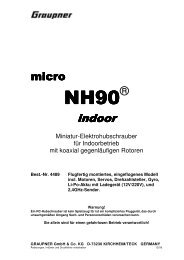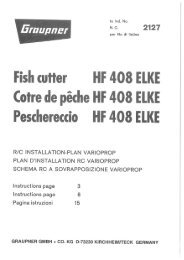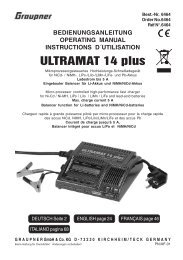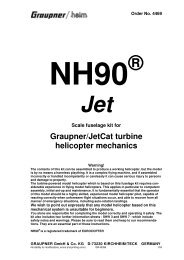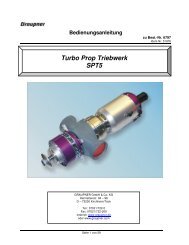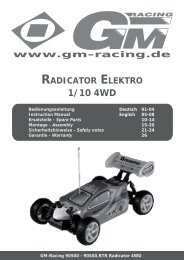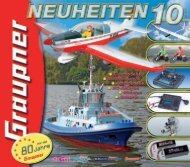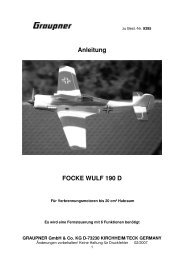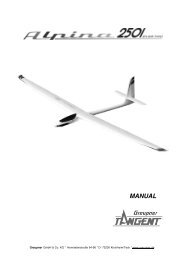Operating Instructions for the Scharnhorst model ship ... - Graupner
Operating Instructions for the Scharnhorst model ship ... - Graupner
Operating Instructions for the Scharnhorst model ship ... - Graupner
Create successful ePaper yourself
Turn your PDF publications into a flip-book with our unique Google optimized e-Paper software.
<strong>Operating</strong> <strong>Instructions</strong> <strong>for</strong> <strong>the</strong> <strong>Scharnhorst</strong> <strong>model</strong> <strong>ship</strong>, Order No.: 2091<br />
History of <strong>the</strong> full-size vessel<br />
• Accurate scale <strong>model</strong> of <strong>the</strong> <strong>for</strong>mer German War Navy’s battle cruiser of 1936. The <strong>Scharnhorst</strong> and<br />
her sister <strong>ship</strong> Gneisenau were <strong>the</strong> first war<strong>ship</strong>s to be built which significantly exceeded <strong>the</strong><br />
specifications laid down by <strong>the</strong> Treaty of Versailles. To avoid provoking a conflict with England, <strong>the</strong><br />
vessels were fitted with <strong>the</strong> relatively weak armament of 28 cm guns, although <strong>the</strong>y carried powerful<br />
armour and had a high top speed of 31.5 kn. Never<strong>the</strong>less <strong>the</strong> <strong>ship</strong>s were not legalised until <strong>the</strong><br />
signing of <strong>the</strong> German-British Fleet Agreement.<br />
• In <strong>the</strong> period up to 1942 <strong>the</strong> two <strong>ship</strong>s participated in a number of joint operations against merchant<br />
<strong>ship</strong>ping, and in support of <strong>the</strong> German occupation of Norway. After <strong>the</strong>ir return to Germany<br />
(Operation Cerberus) <strong>the</strong> Gneisenau lay in dock <strong>for</strong> <strong>the</strong> repair of relatively slight mine damage, when<br />
she was severely damaged in an aerial attack, and was never re-commissioned. In 1945 <strong>the</strong> vessel<br />
was scuttled as part of <strong>the</strong> blockade of <strong>the</strong> entrance to Gotenhafen.<br />
• In December 1943, during an operation (Operation Ostfront) in <strong>the</strong> North Sea against merchant<br />
<strong>ship</strong>ping, <strong>the</strong> <strong>Scharnhorst</strong> was sunk by two British battle groups consisting of <strong>the</strong> battle<strong>ship</strong> HMS<br />
Duke of York, three light cruisers, one heavy cruiser and eight destroyers.<br />
• In September 2000, after protracted research by <strong>the</strong> Norwegian Alf R. Jacobsen in British, German<br />
and Norwegian military archives, and interviews with survivors and surviving dependents, <strong>the</strong> wreck<br />
of <strong>the</strong> <strong>Scharnhorst</strong> was located at a depth of around 300 m, at a point around 160 km North of<br />
Nordkap.<br />
The <strong>model</strong><br />
This boat is a member of <strong>the</strong> GRAUPNER PREMIUM line, a series of particularly high-quality ready-made<br />
<strong>model</strong>s with an unprecedented level of detailing.<br />
The core of this high-quality <strong>model</strong> is <strong>the</strong> robust moulded GRP hull, complemented by <strong>the</strong> superstructure<br />
and deck which are constructed from laser-cut ABS parts. Many of <strong>the</strong> small items are of metal, and<br />
almost everything is factory-assembled. The hull, parts of <strong>the</strong> superstructure, <strong>the</strong> masts and fittings are<br />
spray-finished using semi-matt paints, and <strong>the</strong> decals are already applied. The many details and scale<br />
fittings give <strong>the</strong> boat an impressive scale appearance.<br />
The large deck opening makes it a simple matter to install <strong>the</strong> RC components, and <strong>the</strong> procedure is<br />
quickly completed. To prepare <strong>the</strong> boat <strong>for</strong> running all you have to do is install <strong>the</strong> RC components and <strong>the</strong><br />
drive battery, carry out a little soldering, and <strong>the</strong> <strong>model</strong> is ready <strong>for</strong> <strong>the</strong> water.<br />
Specification<br />
Length approx. 1580 mm<br />
Beam approx. 205 mm<br />
Overall height approx. 405 mm<br />
All-up weight incl. RC approx. 9.5 kg<br />
Scale approx. 1 : 150<br />
Manufacturer’s declaration from <strong>Graupner</strong> GmbH & Co KG<br />
Contents of <strong>the</strong> manufacturer’s declaration:<br />
If material defects or manufacturing faults should arise in a product distributed by us in <strong>the</strong> Federal<br />
Republic of Germany and purchased by a consumer (§ 13 BGB), we, <strong>Graupner</strong> GmbH & Co. KG, D-<br />
73230 Kirchheim/Teck, Germany, acknowledge <strong>the</strong> obligation to correct those defects within <strong>the</strong><br />
limitations described below.<br />
The consumer is not entitled to exploit this manufacturer’s declaration if <strong>the</strong> failure in <strong>the</strong> usability of <strong>the</strong><br />
product is due to natural wear, use under competition conditions, incompetent or improper use (including<br />
incorrect installation) or external influences.<br />
This manufacturer’s declaration does not affect <strong>the</strong> consumer’s legal or contractual rights regarding<br />
defects arising from <strong>the</strong> purchase contract between <strong>the</strong> consumer and <strong>the</strong> vendor (dealer).<br />
Extent of <strong>the</strong> guarantee<br />
If a claim is made under guarantee, we undertake at our discretion to repair or replace <strong>the</strong> defective<br />
goods. We will not consider supplementary claims, especially <strong>for</strong> reimbursement of costs relating to <strong>the</strong><br />
defect (e.g. installation / removal costs) and compensation <strong>for</strong> consequent damages unless <strong>the</strong>y are<br />
GRAUPNER GmbH & Co. KG D-73230 KIRCHHEIM/TECK GERMANY<br />
No liability <strong>for</strong> printing errors. We reserve <strong>the</strong> right to introduce modifications. #0059636 03/2009 1
llowed by statute. This does not affect claims based on legal regulations, especially according to product<br />
liability law.<br />
Guarantee requirements<br />
The purchaser is required to make <strong>the</strong> guarantee claim in writing, and must enclose original proof of<br />
purchase (e.g. invoice, receipt, delivery note) and this guarantee card. He must send <strong>the</strong> defective goods<br />
to us at his own cost, using <strong>the</strong> following address:<br />
Gliders<br />
Brunel Drive, Newark, Nottinghamshire, NG242EG<br />
The purchaser should state <strong>the</strong> material defect or manufacturing fault, or <strong>the</strong> symptoms of <strong>the</strong> fault, in as<br />
accurate a manner as possible, so that we can check if our guarantee obligation is applicable.<br />
The goods are transported from <strong>the</strong> consumer to us and from us to <strong>the</strong> consumer at <strong>the</strong> risk of <strong>the</strong><br />
consumer.<br />
Duration of validity<br />
This declaration only applies to claims made to us during <strong>the</strong> claim period as stated in this declaration.<br />
The claim period is 24 months from <strong>the</strong> date of purchase of <strong>the</strong> product by <strong>the</strong> consumer from a dealer in<br />
<strong>the</strong> Federal Republic of Germany (date of purchase). If a defect arises after <strong>the</strong> end of <strong>the</strong> claim period, or<br />
if <strong>the</strong> evidence or documents required according to this declaration in order to make <strong>the</strong> claim valid are not<br />
presented until after this period, <strong>the</strong>n <strong>the</strong> consumer <strong>for</strong>feits any rights or claims from this declaration.<br />
Limitation by lapse of time<br />
If we do not acknowledge <strong>the</strong> validity of a claim based on this declaration within <strong>the</strong> claim period, all<br />
claims based on this declaration are barred by <strong>the</strong> statute of limitations after six months from <strong>the</strong> time of<br />
implementation; however, this cannot occur be<strong>for</strong>e <strong>the</strong> end of <strong>the</strong> claim period.<br />
Applicable law<br />
This declaration, and <strong>the</strong> claims, rights and obligations arising from it, are based exclusively on <strong>the</strong><br />
pertinent German Law, without <strong>the</strong> norms of international private law, and excluding UN retail law.<br />
Important safety notes<br />
You have acquired a kit which can be assembled into a fully working RC <strong>model</strong> when fitted out with<br />
suitable accessories. However, we as manufacturers have no control over <strong>the</strong> way you build and operate<br />
your RC <strong>model</strong> boat, nor how you install, operate and maintain <strong>the</strong> associated components, and <strong>for</strong> this<br />
reason we are obliged to deny all liability <strong>for</strong> loss, damage or costs which are incurred due to <strong>the</strong><br />
incompetent or incorrect use and operation of our products, or which are connected with such operation in<br />
any way. Unless o<strong>the</strong>rwise prescribed by binding law, <strong>the</strong> obligation of <strong>the</strong> GRAUPNER company to pay<br />
compensation, regardless of <strong>the</strong> legal argument employed, is excluded. This includes personal injury,<br />
death, damage to buildings, damage due to loss of business or turnover, interruption of business or o<strong>the</strong>r<br />
direct or indirect consequent damage whose root cause was <strong>the</strong> operation of <strong>the</strong> <strong>model</strong>.<br />
The total liability in all cases is limited to <strong>the</strong> amount of money which you actually paid <strong>for</strong> this <strong>model</strong>.<br />
This <strong>model</strong> boat is built and operated at <strong>the</strong> sole and express responsibility of <strong>the</strong> operator. The<br />
only way to avoid injury to persons and damage to property is to handle and operate <strong>the</strong> <strong>model</strong><br />
with <strong>the</strong> greatest care and consideration at all times.<br />
Be<strong>for</strong>e you run <strong>the</strong> <strong>model</strong> <strong>for</strong> <strong>the</strong> first time please check that your private third-party insurance covers <strong>the</strong><br />
operation of <strong>model</strong> boats of this kind. If in doubt, take out a special insurance policy designed to cover<br />
<strong>model</strong>ling risks.<br />
These safety notes should be kept in a safe place. If you ever dispose of <strong>the</strong> <strong>model</strong>, be sure to pass <strong>the</strong>m<br />
on to <strong>the</strong> new owner.<br />
The following points are important and must be observed at all times:<br />
• This <strong>model</strong> is not suitable <strong>for</strong> young persons under 14 years of age.<br />
• The projecting parts of <strong>the</strong> <strong>model</strong> may be sharp, and <strong>the</strong> aerials and masts could cause eye injuries.<br />
• Bear in mind that tools can be dangerous; always be careful when handling <strong>the</strong>m.<br />
• Never operate <strong>the</strong> <strong>model</strong> when <strong>the</strong>re are persons or animals in <strong>the</strong> water, as its high speed<br />
constitutes a considerable injury hazard.<br />
• Do not run your <strong>model</strong> in protected sites, animal or plant sanctuaries or sites of special scientific<br />
interest (SSSIs). Check with your local authority that <strong>the</strong> stretch of water you wish to use is suitable <strong>for</strong><br />
<strong>model</strong> boats.<br />
GRAUPNER GmbH & Co. KG D-73230 KIRCHHEIM/TECK GERMANY<br />
No liability <strong>for</strong> printing errors. We reserve <strong>the</strong> right to introduce modifications. #0059636 03/2009 2
• Never run <strong>the</strong> boat in salt water.<br />
• Never run <strong>the</strong> boat in adverse conditions, e.g. rain, storm, strong wind, choppy water or strong<br />
currents.<br />
• Read <strong>the</strong> instructions provided with your radio control system and accessories, and observe <strong>the</strong><br />
recommendations.<br />
• Be<strong>for</strong>e you run <strong>the</strong> <strong>model</strong> check that <strong>the</strong> radio control system is working reliably, and that all<br />
connections are secure.<br />
• Dry batteries must never be recharged. Only batteries marked as “rechargeable” are safe to recharge.<br />
• Check <strong>the</strong> range of <strong>the</strong> radio control system be<strong>for</strong>e each session: ask a friend to walk about 100 m<br />
away from <strong>the</strong> <strong>model</strong> carrying <strong>the</strong> transmitter. Your friend will be able to tell you whe<strong>the</strong>r all <strong>the</strong><br />
working functions operate correctly at this range.<br />
• Ensure that <strong>the</strong> frequency you intend to use is not already in use by o<strong>the</strong>r <strong>model</strong>lers. Never run your<br />
boat if you are not certain that your channel is free.<br />
• Bear in mind that o<strong>the</strong>r radio equipment and transmitting stations can cause serious interference to<br />
<strong>the</strong> <strong>model</strong>. Ensure that no equipment of this type is being used in <strong>the</strong> vicinity while you are operating<br />
<strong>the</strong> <strong>model</strong>.<br />
• Do not carry out any work on <strong>the</strong> drive train unless you have disconnected and removed <strong>the</strong> battery.<br />
• When <strong>the</strong> drive batteries are connected, keep well clear of <strong>the</strong> area around <strong>the</strong> propellers, and make<br />
sure any spectators do <strong>the</strong> same.<br />
• Do not be tempted to exceed <strong>the</strong> recommended operating voltage. Higher voltages may cause <strong>the</strong><br />
motors or speed controller to overheat, and <strong>the</strong> electrical cables may even melt. If this should happen,<br />
<strong>the</strong> <strong>model</strong> could easily be ruined.<br />
• Check that all <strong>the</strong> drive train components work smoothly and freely. This applies in particular when <strong>the</strong><br />
boat is running, as leaves and o<strong>the</strong>r debris may get caught in <strong>the</strong> power system components. The<br />
motors and speed controller could <strong>the</strong>n be ruined by overloading.<br />
• Dry cells and rechargeable batteries must never be short-circuited. Do not allow <strong>the</strong>m to come into<br />
direct contact with water.<br />
• Remove <strong>the</strong> rechargeable batteries and <strong>the</strong> dry cells in <strong>the</strong> transmitter and receiver pack if <strong>the</strong> <strong>model</strong><br />
is to be transported, or will not be used <strong>for</strong> a long period.<br />
• Do not subject <strong>the</strong> <strong>model</strong> boat to high levels of humidity, heat, cold or dirt.<br />
• Secure <strong>the</strong> <strong>model</strong> and your RC equipment carefully when transporting <strong>the</strong>m. They may be seriously<br />
damaged if <strong>the</strong>y are free to slide about.<br />
• Never operate <strong>the</strong> boat in moving water (e.g. a river), as its low speed may result in <strong>the</strong> <strong>model</strong> drifting<br />
off downstream.<br />
• If you have to salvage <strong>the</strong> <strong>model</strong>, take care not to risk your own life or that of o<strong>the</strong>rs.<br />
• Take particular care to ensure that <strong>the</strong> boat is completely watertight, as it will sink if too much water<br />
enters <strong>the</strong> hull. Check <strong>the</strong> <strong>model</strong> <strong>for</strong> damage be<strong>for</strong>e every run, and ensure that water cannot penetrate<br />
through <strong>the</strong> shaft bearings.<br />
• Allow <strong>the</strong> boat to dry out thoroughly after each session.<br />
• Be sure to check repeatedly during <strong>the</strong> first run that <strong>the</strong> shaft system is watertight. If water enters <strong>the</strong><br />
hull through <strong>the</strong> shaft tube, remove <strong>the</strong> shaft and lubricate <strong>the</strong> tube with plenty of grease, Order No.<br />
570.<br />
• NOTE: it is important not to dispose of <strong>the</strong> electric motors installed in <strong>the</strong> <strong>model</strong> in <strong>the</strong> ordinary<br />
household waste. They must be removed from <strong>the</strong> boat and taken to <strong>the</strong> appropriate collection point<br />
<strong>for</strong> electrical waste.<br />
• NOTE: if you install two drive batteries and wire <strong>the</strong>m in parallel, <strong>the</strong>y should only be connected while<br />
you are operating <strong>the</strong> boat, as inter-actions can occur between <strong>the</strong> two batteries under no-load<br />
conditions, and may cause damage to <strong>the</strong> packs. It is always best to connect <strong>the</strong> batteries just be<strong>for</strong>e<br />
running <strong>the</strong> <strong>model</strong>, and <strong>the</strong>n disconnect <strong>the</strong>m immediately afterwards. On no account store <strong>the</strong> boat<br />
with <strong>the</strong> batteries connected using <strong>the</strong> parallel lead.<br />
Care and maintenance<br />
• Clean <strong>the</strong> <strong>model</strong> carefully after every run, and remove any water which penetrates <strong>the</strong> hull. If water<br />
gets into <strong>the</strong> RC components, dry <strong>the</strong>m out carefully and send <strong>the</strong>m to your nearest GRAUPNER<br />
Service Centre <strong>for</strong> checking.<br />
• Clean <strong>the</strong> <strong>model</strong> and transmitter using suitable cleaning agents only. All you need is a lint-free cloth.<br />
Never use chemical cleaners, solvents, methylated spirits, white spirit or similar.<br />
• Lubricate <strong>the</strong> propeller shafts at regular intervals by applying a small drop of oil to <strong>the</strong> bearings. The<br />
external shaft bearing adjacent to <strong>the</strong> propeller must also be lubricated. Use a type of oil which does<br />
not soil or contaminate water, e.g. Order No. 206. At <strong>the</strong> end of <strong>the</strong> season we recommend that you<br />
remove <strong>the</strong> propeller shaft and re-lubricate it using water-neutral grease, e.g. Order No. 570.<br />
GRAUPNER GmbH & Co. KG D-73230 KIRCHHEIM/TECK GERMANY<br />
No liability <strong>for</strong> printing errors. We reserve <strong>the</strong> right to introduce modifications. #0059636 03/2009 3
Assembling <strong>the</strong> <strong>model</strong><br />
• Carefully unpack <strong>the</strong> <strong>model</strong> and <strong>the</strong> boatstand.<br />
• To remove <strong>the</strong> superstructure grasp it carefully by <strong>the</strong> battle bridge and <strong>the</strong> rear rangefinder, and lift it<br />
up vertically.<br />
• Solder G2 connectors to <strong>the</strong> central motor. The<br />
outer motors should be wired in parallel, and<br />
<strong>the</strong>n soldered to G2 connectors, referring to <strong>the</strong><br />
wiring diagram on page 6 (+ is red, - is black).<br />
Check <strong>the</strong> direction of rotation of <strong>the</strong> motors<br />
when <strong>the</strong> battery is connected: <strong>the</strong> propellers<br />
must rotate in such a way that <strong>the</strong> <strong>model</strong> would<br />
be propelled <strong>for</strong>ward. NOTE: <strong>the</strong> raised lug on<br />
<strong>the</strong> plastic housing of all G2 connectors should<br />
always be <strong>the</strong> positive terminal (red wire). If you<br />
keep consistently to this principle, your batteries<br />
and speed controllers will be interchangeable,<br />
and <strong>the</strong> system will be protected against<br />
accidental reversed polarity. We recommend<br />
that you follow <strong>the</strong> tips outlined below, which<br />
will make it easier to solder <strong>the</strong> connectors. The<br />
procedure described will also help to avoid damaging detail fittings on <strong>the</strong> <strong>model</strong> with <strong>the</strong> hot<br />
soldering iron. TIP 1: remove <strong>the</strong> motors: undo <strong>the</strong> grubscrews in <strong>the</strong> propellers so that <strong>the</strong> propellers<br />
can be withdrawn. Now undo <strong>the</strong> motor retaining screws (don’t remove <strong>the</strong>m completely) and slide<br />
<strong>the</strong> motors <strong>for</strong>ward until <strong>the</strong> shaft couplings are exposed. Undo <strong>the</strong> grubscrews in <strong>the</strong> couplings which<br />
clamp <strong>the</strong> motor shafts, <strong>the</strong>n remove <strong>the</strong> motors from <strong>the</strong> <strong>model</strong>. The motors and propellers can be<br />
re-installed simply by reversing <strong>the</strong> whole procedure. TIP 2: if you have a friend to help you, ask him<br />
or her to support <strong>the</strong> boat at an angle so that you can hold <strong>the</strong> motor wires outside <strong>the</strong> hull <strong>for</strong><br />
soldering; any excess solder will <strong>the</strong>n fall away from <strong>the</strong> <strong>model</strong>. TIP 3: a “third hand” is a useful<br />
clamping tool which you can use to hold <strong>the</strong> wires <strong>for</strong> soldering directly inside <strong>the</strong> <strong>model</strong>.<br />
• Check that <strong>the</strong> screws in <strong>the</strong> shaft couplings, <strong>the</strong> motor retaining bars and <strong>the</strong> propellers are really<br />
tight, as <strong>the</strong>y may have worked loose in transit. You can check this by pulling on <strong>the</strong> propellers; if you<br />
find you can move <strong>the</strong> shafts to <strong>the</strong> rear, <strong>the</strong>n one of <strong>the</strong> grubscrews is loose. Tighten <strong>the</strong> offending<br />
item carefully, using TIP 1 as described above in order to gain access to <strong>the</strong>m. IMPORTANT: if <strong>the</strong><br />
grubscrews are loose, apply a drop of thread-lock fluid to <strong>the</strong>m, e.g. UHU schraubensicher, Order No.<br />
952, as vibration could cause <strong>the</strong>m to work loose again while <strong>the</strong> boat is running.<br />
• Drill out <strong>the</strong> outer hole in <strong>the</strong> servo output arm<br />
to 2 mm diameter and attach <strong>the</strong> pushrod<br />
connector to it. IMPORTANT: take care not to<br />
damage <strong>the</strong> servo lead by trapping it under one<br />
of <strong>the</strong> screws. TIP: if you are unable to find a<br />
drill long enough <strong>for</strong> this job at your <strong>model</strong> shop<br />
or DIY shop, one solution is to glue (or - better -<br />
solder) a 1.5 mm Ø drill bit in a length of brass<br />
tube with an internal diameter of 1.6 mm Ø (e.g.<br />
Order No. 564.3).<br />
• Set <strong>the</strong> rudder to ‘Straight <strong>for</strong>ward’ and slide <strong>the</strong><br />
rudder pushrod in <strong>the</strong> pushrod connector. The<br />
rudder servo must be centred, too and <strong>the</strong>n <strong>the</strong><br />
rudder pushrod can be tightened.<br />
• Solder a 20 cm length of twin-core cable to<br />
each of <strong>the</strong> drive batteries, and attach G2 plugs<br />
to <strong>the</strong> free ends. The batteries are secured in <strong>the</strong> <strong>model</strong> using Velcro (hook-and-loop) tape. Apply<br />
adhesive tape over <strong>the</strong> terminals to avoid any risk of short-circuits. NOTE: <strong>the</strong> Velcro tape provides<br />
an easy method of adjusting <strong>the</strong> battery position, in order to achieve <strong>the</strong> correct <strong>for</strong>e-and-aft trim. TIP:<br />
once you have established <strong>the</strong> correct trim, mark <strong>the</strong> position of <strong>the</strong> batteries using a waterproof felttip<br />
pen so that you can be sure of re-installing <strong>the</strong>m in <strong>the</strong> correct position.<br />
GRAUPNER GmbH & Co. KG D-73230 KIRCHHEIM/TECK GERMANY<br />
No liability <strong>for</strong> printing errors. We reserve <strong>the</strong> right to introduce modifications. #0059636 03/2009 4
• Install <strong>the</strong> receiver and <strong>the</strong> speed controller<br />
adjacent to <strong>the</strong> motors using Velcro tape.<br />
• The receiver aerial should be deployed as close<br />
as possible to <strong>the</strong> superstructure coaming, and<br />
fixed in place with strips of adhesive tape. The<br />
aerial must be fitted above <strong>the</strong> waterline, as it will<br />
not pick up a signal if it is below <strong>the</strong> surface.<br />
• Now assemble <strong>the</strong> enclosed parts (cannon and<br />
crane) as illustrated on <strong>the</strong> photo. The cranes<br />
must not be glued, because o<strong>the</strong>rwise <strong>the</strong><br />
superstructure can only be detached very hardly.<br />
• It is up to you to fix <strong>the</strong> strut emblem by using<br />
superglue. NOTE: right after outbreak of <strong>the</strong> war<br />
<strong>the</strong> strut emblems were demounted and had no<br />
longer be used. This is <strong>the</strong> reason why <strong>the</strong>se<br />
parts were packed separately and included in <strong>the</strong><br />
kit.<br />
GRAUPNER GmbH & Co. KG D-73230 KIRCHHEIM/TECK GERMANY<br />
No liability <strong>for</strong> printing errors. We reserve <strong>the</strong> right to introduce modifications. #0059636 03/2009 5
GRAUPNER GmbH & Co. KG D-73230 KIRCHHEIM/TECK GERMANY<br />
No liability <strong>for</strong> printing errors. We reserve <strong>the</strong> right to introduce modifications. #0059636 03/2009 6
Wiring diagram<br />
Motor<br />
Motor<br />
Motor<br />
to particular speed controller<br />
3061<br />
2 x<br />
G2 connectors<br />
G2 connectors<br />
Speed controller<br />
middle motor<br />
Speed controller<br />
outer motors<br />
Drive batterie<br />
Drive batterie<br />
G2 connectors<br />
G2 connectors<br />
Servo V-cable 3936.11<br />
to receiver<br />
Maiden run<br />
Charge up all <strong>the</strong> batteries and test <strong>the</strong> <strong>model</strong>’s working systems one by one. Check that all <strong>the</strong> parts<br />
which are not permanently attached are firmly seated. Now you are ready <strong>for</strong> <strong>the</strong> boat’s maiden run. Keep<br />
<strong>the</strong> its speed low at first, and give yourself plenty of time to become familiar with its handling. The <strong>model</strong><br />
has quite a turn of speed, its minimum turning radius is large and its braking distance long. For this reason<br />
it should only be operated on a fairly large stretch of water.<br />
We hope you have many hours of pleasure running your <strong>model</strong> of <strong>the</strong> <strong>Scharnhorst</strong>.<br />
Replacement part<br />
Order No. 2091.6 Replacement propeller set (3 off)<br />
You will also need <strong>the</strong> following items (not included in <strong>the</strong> set)<br />
Order No. Description<br />
4729 X-408 ECO-SPORT SYSTEM FM RC set, 40 MHz<br />
or<br />
4714 X-412 FM RC set, 40 MHz<br />
2875 NAVY V40R speed controller (two required)<br />
769 Lead-acid drive battery, 6 V / 4 Ah (four required)<br />
3061 G2 parallel lead (two required)<br />
2989.5 G2 connector system <strong>for</strong> <strong>the</strong> speed controller and drive batteries<br />
3389 High-flex copper cable, red / black, each 1 m long<br />
3368 Velcro (hook-and-loop) tape<br />
3936.11 Y-lead<br />
1177 Link socket (one required)<br />
GRAUPNER GmbH & Co. KG D-73230 KIRCHHEIM/TECK GERMANY<br />
No liability <strong>for</strong> printing errors. We reserve <strong>the</strong> right to introduce modifications. #0059636 03/2009 7<br />
3061<br />
3061



